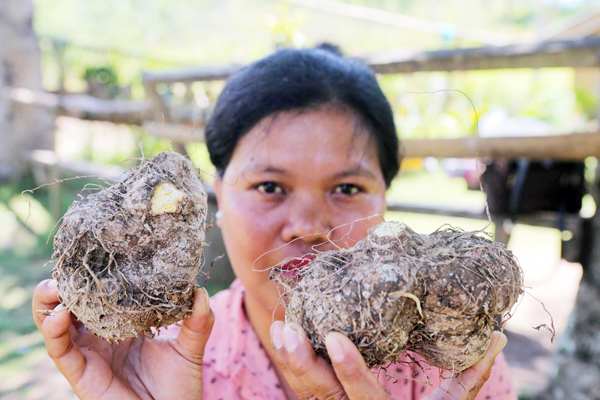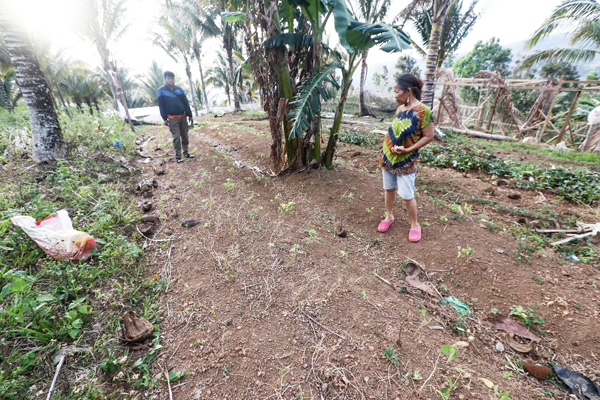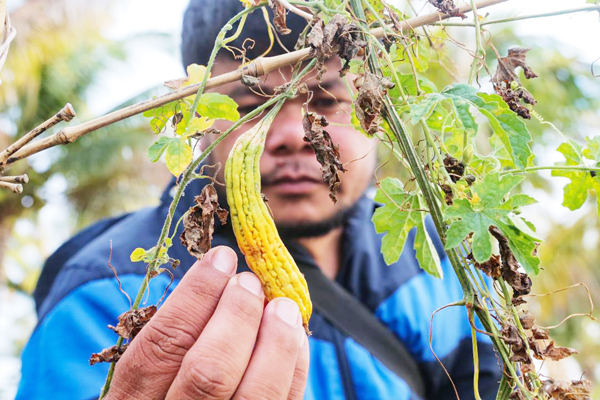SOUTH UPI, Maguindanao del Sur – Teduray farmer Alan Olubalang could still remember how his grandparents scoured the forests of this mountainous town just to find the indigenous crop known as “kayos” at the height of the dry spell in 1998.

MANILYN Elon shows freshly picked 'kayos' in Barangay Kuya, South Upi, Maguindanao del Sur. (Keith Bacongco)
As the dry spell left thousands of hectares of parched farmlands and mountains, many of the indigenous peoples back then were left with no choice but to look and eat kayos.
“It was so dry, very hot and many people had nothing to eat,” Olubalang recounted. “I could still remember my grandmother slicing kayos in our yard so that we will have something to eat.”
Little did they know that some of their fellow IPs had already died due to kayos poisoning.
Despite of the risk, kayos could mean life or death for the IPs in times of crisis.
According to the Tedurays, they are aware that kayos could kill them if it is not properly prepared.
“We were left with no choice because most of our crops were damaged by the extreme heat. It’s like a gamble but would die of starvation too if we will not eat,” recalled Olubalang, who was still 10-years-old when the El Niño phenomenon wreaked havoc in many parts of the country.
In a World Bank report published in 2019, the 1997 to 1998 dry spell was the most severe to have hit the country as rainfall fell to half of historical levels and caused drought in two-thirds of the country.
The report added that the dry spell led to forest fires that destroyed almost 10,000 hectares of natural forests.
Also known as kollot, korot, or nami, kayos (Dioscorea hispida) is a type of wild root crop that usually grows in the forests and could survive even in extreme heat conditions.
Olubalang said that kayos only flourish during dry season. “When it’s wet season, its fruit isn’t good for consumption since its fruit doesn’t grow well.”
Manilyn Elon, who hails from the mountainous village of Kuya, said that they many of them are now consuming kayos as many of their crops had withered due to dry spell.
Despite of risk, Elon said that they are very careful in preparing kayos before eating.
She bared that one of the methods in preparing kayos is to sun dry it for three to four days to remove the poison. For those living near rivers, they wash sliced kayos in the water to remove the poison, she added.
“If it’s not processed properly, kayos can induce paralysis or sickness. You would feel like a drunk. Worse, it could also kill you,” Elon said.

TEDURAY farmers inspect their ‘sulagad’ farm damaged by the dry spell in Barangay Looy, North Upi, Maguindanao del Norte. (Keith Bacongco)
For the Teduray people, kayos is historically known as their famine food.
Olubalang said that consuming kayos during dry spell was passed on through generations of IPs.
“We are all aware the risk of consuming kayos but it has been a part also of our practices to be able to survive during prolonged dry spell,” he said.
He theorized that those who died in the past due to kayos poisoning may have not processed the root crop very well. “Maybe they were in a hurry and they have not processed the kayos properly because they had been starving already.”
Barangay Kuya Chairman Victor Lumao confirmed that some of his constituents are consuming kayos.
No kayos poisoning incident has been reported yet as of posting time.
Lumao said that some of his constituents were forced to eat kayos due to lack of alternative food sources during the dry season.
He said that many of his fellow IPs died due to kayos poisoning in the past. “’Yan lang kasi ang nabubuhay na makain namin sa mga kagubatan tuwing tag-init (Kayos is the only crop we could eat during the dry season).”
But unlike in the past, Lumao said people have not yet learned to plant permanent crops like coconuts and other fruit trees.
“Plus the road conditions here in the 1990s were worst, sometimes it takes days to travel from Upi to Datu Odin Sinsuat. So the delivery of any food assistance was very difficult at that time. A lot of our people here were already starving so they resort into eating kayos,” Lumao said.
According to residents, it used to take up to three days to travel from Upi to Datu Odin Sinsuat, which was just at least 32 kilometers away, due to very bad road conditions.
Ongoing validation
Ministry of Agriculture, Fisheries, and Agrarian Reform in the Bangsamoro Autonomous Region in Muslim Mindanao chief Mohammad Yacob said that validation is still ongoing to determine the impact of the prolonged dry spell in the region.
But the BARMM Disaster Risk Reduction and Management Council placed the region from white alert to blue alert status or bravo emergency on April 5 due to the impact of El Niño phenomenon.
Under this status, the Bangsamoro government activated its Bangsamoro Action Plan (BAP) on El Niño.
It also directed local disaster offices from the provincial to municipal levels to conduct Rapid Damage Assessment and Needs Analysis (RDANA) to determine the extent of the damage due to dry spell.
The Bangsamoro government assured its constituents that there are enough funds and other forms of assistance for affected communities.
BARMM is composed of the provinces of Basilan, Maguindanao del Norte, Maguindanao del Sur, Sulu, and Tawi-Tawi.
According to the Philippine Atmospheric, Geophysical, and Astronomical Services Administration (PAGASA) climate outlook, Maguindanao del Norte and Maguindanao del Sur are among provinces in country with below normal rainfall this April.
The State weather bureau noted that Maguindanao is one of the seven provinces in Mindanao with dry spell conditions.
Under dry spell condition, the agency said the area has experienced two consecutive months of below normal rainfall condition or 21 to 60 percent average rainfall reduction.

ALLAN Olubalang shows a withered ampalaya (bitter gourd) at their ‘sulagad’ farm damaged by the dry spell in Barangay Looy, North Upi, Maguindanao del Norte. (Keith Bacongco)
As a result, many farmers in Maguindanao opted not to plant crops in anticipation of the impact of the El Niño.
But for some Teduray farmers in this town, preparedness and resiliency could still help them overcome this crisis.
Olubalang and his fellow indigenous farmers encouraged their neighbors to practice their indigenous farming system known as “sulagad.”
Under this traditional farming, system, IPs integrate various tree species, vegetable crops, and animals into their farms and supplemented by hunting and gathering in the forests.
Olubalang said it is almost similar to the diversified farming system but with the integration of the forests as an extension of their farms.
“As IPs, our lives cannot be detached from nature. The forests have been a part of our daily life as sources of our food and medicine.”
He pointed out the importance of planting sulagad during the prolonged dry spell to enable them to have alternative food sources. “If our backyards farms could not survive the extreme heat, we can always go to forests to look for food. And that’s where most the kayos comes from.”
Lessons from kayos
But despite the risk, why many of the indigenous peoples still turn into kayos in times of hunger?
Olubalang theorized that it must be the nature’s way of teaching the people to share the prepared kayos to the starving community.
“You cannot hide from your neighbors when you are preparing it. Because your neighbors will see drying the sliced kayos under the Sun. Or they will see you processing or washing the kayos in the rivers.”
Kayos is unlike other root crops such as cassava or sweet potatoes that people can hoard and cook behind closed doors, Olubalang added. “Tinuturuan tayo ng kayos na bigyan rin ang iba na nagugutom lalo na ang mga marunong mag proseso nito.”